Children's Books

Collection “L'Art en jeu”
[Art Play Books]
Edited by ╔lizabeth Amzallag-AugΘ
et Sophie Curtil.
36 pp., hardbound, illus., 20.5 x 20.5 cm.
Price: 80 FF.
A series of books designed to introduce children to the
pleasure of twentieth-century art. Each painting or sculpture,
chosen from the collections of the MusΘe national d'art moderne,
reveals its secrets page after page through images, questions,
drawings, and games.
 |
new
Joaquin
TorrΦs Garcia
Composition universelle
1998. 20 x 20 cm, 36 pp.illustr.
Collection Art en jeu
Price : 80 FF. ISBN 2 85850 988 3 |

This rather solemn title conceals a wonderful inventory of signs
and symbols that recall the creation of the world.
The almost childish drawings (or let us call them primitive)
appear one by one, revealing themselves as they were when first
etched into clay or stone.
First comes the fish, as simple as the shape cut out by French
children on 1st April; then the sun and its rays forming hair,
followed by the crescent moon, the stars (of David), and waves in
the shape of zigzags. The backdrop of the Great Universe has been
clearly indicated. Processing slowly in a manner reminiscent of
the story of Noah's Ark are the "beasts which fly, crawl,
and hold themselves erect on their legs". The tone is both
biblical and full of humour. "Between the animals, standing
stiffly erect, is Mankind, a term which means woman + man".
Then, listed as if in a catalogue, come human conquests and
inventions - boats, houses, the wheelbarrow, or the train, always
sketched with just a few lines and simple shading.
Author: Sophie Curtil
Titles available in French only
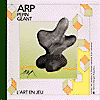 |
Jean Arp, PΘpin
gΘant
1987. ISBN 2 85850 388 5 - OF 3100
|

The Giant Pip leaves its base and wanders through the natural
environment in all four seasons of the year. It becomes a giant
pebble worn smooth by the sea, a cloud or bird, wings
outstretched in the vast, blue sky, a pip in an enormous piece of
fruit, or a snowman. Jean Arp’s sculpture is always
indefinable.
 |
Pierre Bonnard, L'Atelier au mimosa
1988. ISBN : 2 85850 482 2- FO 3106
|

The Studio with Mimosa: Mimosa is the yellow ochre that sparkles
through the window of the artist’s studio. On the canvas,
transparency and mirrors create an amazing universe in which back
and front are of equal value. The scenery is a tapestry, the page
can be folded and unfolded like a curtain.
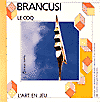 |
Constantin Brancusi, Le Coq
1990. ISBN : 2 85850 548 9 - FO 3114
|

The various Cockerels created by Brancusi are all presented here.
Playing with the bases that are an integral part of the works,
and with the materials used for each of the sculptures (bronze,
stone, plaster or wood), the author provides an introduction to
the combinative world of the great Romanian artist.
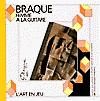 |
Georges Braque, Femme α la guitare
1987. ISBN : 2 85850 389 3 - FO 3101
|

The artist is a magician who conjures up objects and characters,
transforms them and makes them disappear. The painter is also a
musician, playing with lines and colours as if they were notes of
music. Each painting has its own melody. Listen to the one played
by the Woman with the Guitar
 |
Alexander Calder, Fishbones
1989. ISBN : 2 85850 477 6 - FO 3111
|

Yellow. Blue. Red. Black and white. Forms take shape and come to
life: a blue fish, a red fish, black stars. Calder, the
"king of wire", articulates them on long metal rods,
creating a mobile which sways and changes shape with the wind.
 |
Marc Chagall,
Double portrait au verre de vin
1993. ISBN: 2 85850 719 8 - OF 4991
|

This Double Portrait with a Wine Glass tells the love story of
Marc Chagall and his young wife, Bella. Yet, quite apart from his
own story, the primeval painter celebrates on canvas the marriage
of all creatures with water and fire, air and earth.
 |
Gaston
Chaissac
Personnage aux cheveux verts, roses et blancs
Edited by Max-Henry de Larminat
1998. 36 pp., illus., 20 x 20 cm.
Art Play Book series (available in French only)
Price : 80 FF. ISBN 2 85850 959 X
|

The book opens like a wallpaper catalogue with torn pages. :
lambeau jaune comme les blΘs, tache bleue de ciel, touches de
vert empruntΘes aux taillis...
Un dr⌠le de personnage aux cheveux verts, roses et blancs se
fait un habit de voyage de ces morceaux colorΘs et se promΦne
dans un puzzle qui ressemble fort au bocage vendΘen cher α Gaston
Chaissac.
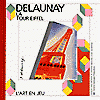 |
Robert Delaunay, La Tour Eiffel
1988. ISBN : 2 85850 430 X - FO 3105
|

The Eiffel Tower, one of the artist’s favourite subjects.
Impossible to take in at a single glance. The metallic
architecture unfolds, bends, glows red and explodes in a gigantic
kaleidoscope. Varying forms and colours give an indication of how
the painter caught the subject in his brushwork
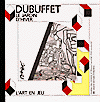 |
Jean Dubuffet, Le Jardin d'Hiver
1989. ISBN : 2 85850 497 0 - FO 4109
|

Follow the thread. Accompanied by a strange guide, young readers
push open a door into the artist’s world, discovering the
black and white plants of the Winter Garden from which strange,
brightly-coloured creatures spring out…
 |
Marcel Duchamp, Porte chapeau
1992. ISBN : 2 85850 701 5 - FO 3123
|

On the chessboard, a strange shape appears. A sort of hook. Then
it unfolds and multiplies, resembling the horns of a chamois, the
tentacles of an octopus, a star fish. Where do these weird
creatures come from? It gradually becomes clear that the claws
are made of wood and that they throw back flying hats! Nothing
strange about that since this is a Hatstand raised to the
dignified position of work of art by Marcel Duchamp when, in
1913, he invented his famous Ready-mades…
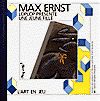 |
Max Ernst, Loplop prΘsente une jeune
fille
1991. ISBN : 2 85850 633 7 - FO 3121
|

The book opens with a keyhole that reveals the hidden world of
dreams. The round eye staring at the reader belongs to the
visionary artist, Max Ernst, the creator of Lolop Introduces a
Young Girl. The Surrealist collage is built up before the
reader’s eyes, each object being placed in the composition
created by the artist. What connection can there be between a
washboard, a horse’s mane, a painted pebble, a frog etc.?
These lost objects become riddles - and the reader is left to
invent his or her own poem…
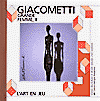 |
Alberto Giacometti, Grande femme II
1989. ISBN : 2 85850 481 4 - FO 3108
|

The sculptor tirelessly modelled long, thin figures throughout
his life. The smallest ones would fit into a matchbox; the
largest would make a hole in a ceiling of normal height. The Tall
Woman II looks tiny here, behind a cut-out window, or huge when
spread over four pages.
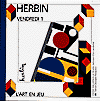 |
Auguste Herbin, Vendredi 1
1994. ISBN : 2 85850 755 4 - FO 3126
|

This work is named after a day of the week. A twenty-four hour
day. And look, the painting also has twenty-four shapes which
slot into each other like the parts in a gear. Hours of the day,
hours of the night, the hands on the clock complete a revolution,
following the rhythm of the planets. Varying shapes and colours
enhance the symbolic dimension of this work.
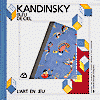 |
Vassily Kandinsky, Bleu de ciel
1988. ISBN : 2 85850 480 6 - FO 3107
|

To take us from the infinitesimally small to the infinitely
large, Sky Blue is looked at as if through a microscope lens or a
telescope. The artist has filled it with strange creatures.
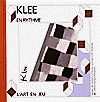 |
Paul Klee, En rythme
1993. ISBN : 2 85850 715 5 - FO 3125
|

One! Two! Three! Black! Grey! White! …
This amusing musical dictation forms the opening of the book.
Touches of colour succeed each other, laid out like notes of
music, taking us all at the same rhythm into the heart of the
painting whose title indicates the keyword for this work.
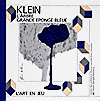 |
Yves Klein, L'Arbre, grande Θponge
bleue
1994. ISBN : 2 85850 752 X - FO 4992
|

The Tree, large blue sponge begins with a tiny royal blue dot,
like a planet lost in the vastness of the sky. Then we move
closer to an unknown land which gradually reveals its strange
plant life. Is it an island of lava or coral? No, it is an
astonishing plant sculpture.
 |
Frantisek Kupka, Autour d'un point
1991. ISBN : 2 85850 609 4 - FO 3120
|

This painting is gradually revealed Around a dot. The first
impression is a view through a magnifying glass. Does the
isolated detail correspond to the gaudy designs of a butterfly
wing? Or, seen through a telescope, is this a planet dazzling in
the night sky or a shower of stars? The artist’s brushes are
filled with magic and, on the canvas, the artist recreates a
feeling of movement and the infinity of space.
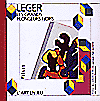 |
Fernand LΘger, Les Grands plongeurs
noirs
1985. ISBN : 2 85850 314 1 - FO 3102
|

The divers appear in turn - first the black ones, then the blues,
the yellows, the reds etc. They become grey and black or
disappear. This is how Fernand LΘger’s work The Great Black
Divers is gradually revealed.
 |
Casimir MalΘvitch, L'Homme qui court
1996. ISBN : 2 85850 865 8 - FO 4995
|

A succession of 30 squares is revealed as the pages are turned.
Close-ups show the vividly-coloured painted matter and the
perfect harmony between the geometry and the symbolism of the
motifs - vertical lines in crosses and swords, horizontal strips
beneath the feet of the Man Running. The title is repeated and
recomposed: The Man - running - Running - the Man…
suggesting his rhythm, and the breathlessness of the fugitive.
 |
RenΘ Magritte, Le Double secret
1989. ISBN : 2 85850 534 9 - FO 3103
|

Cut-outs and hiding places reveal Magritte’s sense of humour
and ability to weave spells. The "cut-out" head reveals
the interior of the character and is an ideal opportunity to
explore, in imagination, the world of the painter.
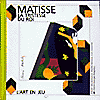 |
Henri Matisse, La Tristesse du Roi
1991. ISBN : 2 85850
594 2 - FO 3117
|

Simple shapes, cut out in coloured paper, seem to float off the
paper before our eyes and regroup as the pages are turned.
Is this a sun or an orange? A flower or a hand? Gradually the
composition takes shape and the outlines become clearer. As if we
were in Matisse’ studio, his work The Sadness of the King
comes into being before us in its dazzling harmony, thanks to the
magic of a few snips of the scissors.
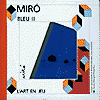 |
Joan Mir≤ Bleu II
1990. ISBN : 2 85850 547 0 - FO 3112
|

Blue as a summer sky, blue as a calm sea… For Mir≤, blue is
the colour of his dreams. A row of black dots and a splash of red
cross the immense space, bringing life to the canvas like a
celestial piece of music. Everybody can decipher his or her own
impression of what is hidden in a bareness taken to its extreme.
By a series of frames and perspectives, the artist gives a few
clues…
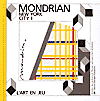 |
Piet Mondrian, New York City 1
1992. ISBN : 2 85850 654 X - FO 3122
|

Red, yellow and blue rectangles. Vertical and horizontal lines
cutting across each other. Into infinity. Hiding places and
cut-outs explore the varying geometric patterns. The author of
the book skilfully reveals how Mondrian, nourished and steeped in
the noisy frenzy of New York, achieved such pure lines, like a
window wide open on the New World.
 |
Louise Nevelson, Tropical garden II
1997. ISBN : 2 85850 905 0 - FO 4996
|

Fifteen black, up-ended wooden boxes
gradually reveal their secrets. They are inhabited by mysterious
objects, made of fragments of planks, pieces of wood retrieved
here and there, glued, nailed into place… There are totem
poles, coffins or scorched trees. Yet the boxes also form a
tropical garden whose outlines are reminiscent of the skyscrapers
of New York city where the artist spent nearly the whole of her
life.
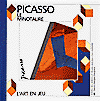 |
Pablo Picasso, Le Minotaure.
1987. ISBN : 2 85850 428 8 - FO 3104
english version : 80
FF
ISBN : 2 85850 431 8 - FO 3115
|

Picasso always identified with the Minotaur. He stated that
"If somebody drew a line through all the places I have
visited during my life, it may well form the outline of a
Minotaur." The creature is running away, providing an excuse
for a race through the creative imagination of this sacred
monster.
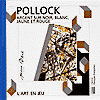 |
Jackson Pollock, Argent sur noir,
blanc, jaune et rouge
1995. ISBN : 2 85850 814 3 - FO 4994
|

Splashes, splatters, drips… Pollock invented the dripping
technique which consists of throwing paint onto a canvas laid on
the floor.
A cut-out isolates one detail, round as a planet. A frame takes
us into a forest. Close-ups of arabesques suggest vast silvery
rivers… There are strange resemblances between the graphics
of Mother Nature and the writing of the artist who
"danced" around his canvas like Red Indian painters
from the Wild West.
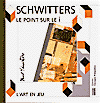 |
Kurt Schwitters, Le Point sur le i
1994. ISBN : 2 85850 804 6 - FO 3127
|

Schwitters fills his pockets with the thousand and one pieces of
paper that litter pavements - theatre tickets, paper cuttings,
stamped envelopes etc. The artist then snips away at these
materials and glues them to create Dotting the
"i’s", in which he makes subtle use of colour
harmonies. The small reproduction of the work is folded into an
envelope - and young readers are invited to collect papers in the
envelope to make their own collages.
 |
Yves Tanguy, Jour de lenteur
1991. ISBN : 2 85850 570 5 - FO 3118
|

The Slow Day opens with a vast landscape spread over four pages.
Black shadows are dotted across it, revealing the presence of
strange, coloured shapes. Are they men from outer space? Engines
of war? Phantom ships? The author suggests and questions but
states nothing with any certainty. Did Tanguy himself have the
answer? Making skilful use of frames, the painting is presented
like a stage set, revealing a world of pretence and secret lives.
 |
Bram Van Velde, Sans titre 1936-1941
1989. ISBN : 2 85850 488 1 - FO 3110
|

A strange world which has no name other than
"Nameless". There is a suggestion of a red man, a
toucan, a marmotte… Images appear and disappear, emerging
from the waves of gouache that the artist made increasingly light
and more and more transparent
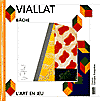 |
Claude Viallat, BΓche
1997. ISBN : 2 85850 806 2 - FO 4993
|

A strange shape appears. Is it a sponge? A bean? A cloud? It
changes colour and shape, turns upside down. Then it multiplies,
occupying long strips of fabric, the brightly-coloured Canvas
that the artist borrows from tents, or from the sails of boats.
Cut-outs on the page suggest the stencils that the artist uses to
play with shapes and "counter-shapes", filling the
front and back of his work with infinite variations.
Titles available in English and French
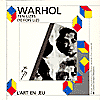 |
Andy Warhol, Ten Lizes.
1990. ISBN : 2 85850 549 7 - FO 3113
english version :
80 FF
ISBN : 2 85850 545 4 - FO 3116
|

Not one but ten Lizes. Superstar Liz Taylor fascinated Andy
Warhol, the king of Pop Art. In this world where "everything
is pretty", there are flowers in sherbet colours. Cut them
out and a series of ten Lizes will smile at you from their paper
frames. Flower-Women or Fatal Beauties, Liz and the Mona Lisa
have the same, fragile smile. Soon to be rubbed out. Yet their
image is eternal, an invitation to many a voyage.
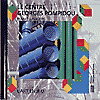 |
Le Centre Georges Pompidou
1996. ISBN : 2 85850 912 3- FO 4997
english version : 80 FF
ISBN : 2 85850 922 0 - FO 4998
japanish version : 85 FF
ISBN : 2 85850 941 7
|

Young readers are invited to discover an architectural work - the
Centre Georges Pompidou. The transparency of the building, which
has been compared to a gigantic animal, gradually reveals its
framework while its brilliant colours (red, blue, yellow, green)
express its vital functions. Unusual details, a humorous text and
an amusing page layout emphasise the joyful audacity of Piano and
Rogers’ architecture.

Latest update tuesday 2 december 1998
⌐ CNAC-GP
































